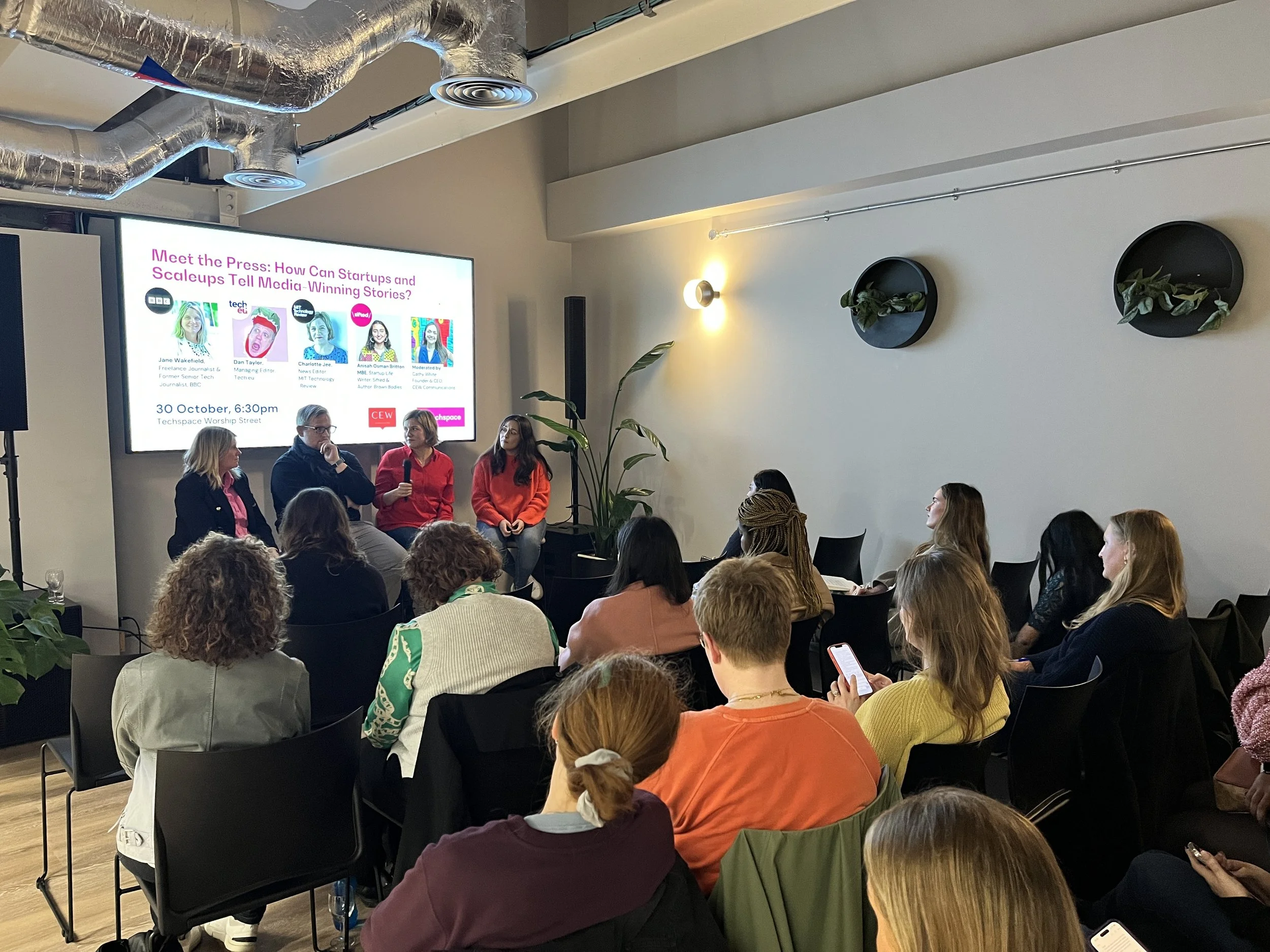How can Startups and Scaleups tell media-winning stories?
Nov 6, 2023
Together with Techspace, we gathered an expert panel of journalists to help startups and founders understand more about creating media-winning stories.
Our panel featured the creme de la creme of tech journalists. We were joined by Jane Wakefield, freelance journalist and former senior tech editor for the BBC; Dan Taylor, managing editor of Tech EU; and Charlotte Jee, news editor for MIT Technology Review.
We’ve taken the top tips from the evening to share with you and answer the common questions startups and scaleups face when pitching their news.
Grab their attention
Like most of us, journalists are very busy people. In fact, they are insanely busy people.
They receive around 200-300 emails daily, so the key is to make your email and story stand out from the crowd. One way to do this is to ensure your subject line is short, interesting and includes a reference to the field you are working in.
Charlotte recommended using clear keywords like “AI” or “Metaverse” in your subject line, as it will be easier to find your email when a journalist is looking to write about your topic in the future.
What you’re offering the journalist needs to be clear.
As a startup, your name means nothing and wastes space in the subject line. Instead, use critical words to the story and make time restraints and offers clear. Such as ‘For next Tuesday” or “Exclusive”.
It is also important to bear in mind that silence can sometimes be a way of a soft rejection. There is no harm in following up once or twice, but any more than that, and it is a great way to end up on their spam list.
…unless you’re pitching Dan Taylor, in which case he is receptive to a few more follow-ups!
Be concise
The best pitch will allow the journalist to understand your story within the first two lines, so with this in mind, keeping things concise is key.
A good tip to remember is the five W’s: Who, What, Where, When, Why (and How) and if you have answered all of those questions in around 1-200 words, you’ll have successfully conveyed your story clearly and concisely.
Bullet points are a great way to convey this as well, as the layout makes for a clear read, so journalists can skim it easily and get all of the relevant information.
Remain objective
It can be hard for a Founder to maintain an objective perspective on their work, but it is crucial when pitching stories to journalists.
What might seem like news to you might not be news to them. It can be helpful to ask yourself questions like: “What is groundbreaking about this story?” or even “Why should people care about it?”.
These questions can also help you find interesting angles, which journalists and readers will be excited by. Another great critical angle is to ask yourself whether it is something you would mention and chat with a friend or partner about. If you don’t think a conversation is likely to develop from it, then it probably isn’t the most newsworthy angle or story to choose.
What makes a good story
The best stories have an authentic and human element at their heart - our panel all emphasized how important it is not to lose this.
Jane shared one of the highlights of the evening: The TRUTH acronym. This is a great tool to use to remind yourself of what makes a good story for a journalist:
Truth (journalism Is based on fact)
Relevant
Unusual
Trouble
Human
Your story doesn’t need to be all of these things, but it should be at least a few.
Pick the right publication
Not every news outlet will be the right fit for every story, so you need to do detailed research before deciding which journalists to pitch to.
Although the big names have a large reach, this doesn’t mean they are the best publication for the story. It would be more effective to pitch to a smaller publication focusing on something that closely links to your news and business, where the readership is more active.
Journalists also have preferences on what they write about, so be sure to research them and the publication. There might be someone specific that covers your field, so finding and targeting them with your pitch is the most successful approach.
It is possible a journalist will pass the story to their colleague if it is more appropriate for them. But it can also lead to being unread as it might be perceived as a general spam comms email.
Use Professional Photos
One of the top tips from Dan Taylor, former “accidental” photographer (for 10 years), was the importance of investing in good photography.
Paying for a proper photo shoot means that your brand looks professional; iPhone images just don’t cut it anymore. Having bad, out-of-focus or grainy imagery used in conjunction with your story will undermine your brand and could end up haunting you for years to come.
It is also important to provide your own photos; if you don’t, you’re creating more work for the journalist, who now has to go and find them.
They will also probably pick one of the first photos they find, which might not be the photo that you want representing your business.
Dan previously wrote this article for Tech EU, filled with advice for startups on photography.
And if you really want their attention, take inspiration from Dan’s roarsome headshot.
Dan Rex. Costume by Brutus.
What’s hot right now…
The panel was asked what they were most interested in covering in the immediate future, and their answer was unanimous: the future of AI.
However, they all stressed that AI development does not mean “an AI plug-in to your software” but specific groundbreaking developments within the tech space that will create real waves.
Jane also highlighted that any green tech developments are particularly sought after at the moment, as we look to how we can make tech itself more ecological, but also how tech can help make our existing world more sustainable.
A big thank you to our panel and Techspace for hosting us! The CEW team will be hosting more events in the future - so watch this space!


